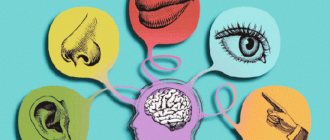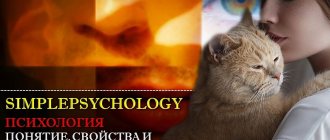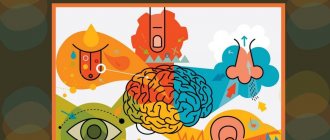tags:
Patient, Sensation, Perception, Hallucination, Hyperesthesia, Internal, Disorder, Anaesthesia Lecture No. 2: Disorder of sensations and perception.
Sensation is the simplest type of cognitive activity, which consists of reflecting individual properties of the attributes of objects, as well as states of the body. Sensation: warmth, cold, pain.
Perception is a holistic reflection of phenomena and objects that arise as a result of the analysis and synthesis of sensations, by comparing them with previous experience.
Representation is the result of the revival of images and phenomena perceived earlier.
-Interoceptive – a signal from the states of the internal processes of the body.
Passing differential sensations. feeling of hunger, calm, comfort.
-Proprioceptive – a signal about the position and movement of the body in space. Formation of an idea of the body: “body diagram”. (vestibular apparatus).
-Extroceptive – the main source of information about the external world (smell, taste, touch).
The most common change in the intensity of sensations.
Pathology of sensations:
- change in intensity of sensations (quantitative):
- hypersthesia
- parasthesia
- asthesia
- painful mental anesthesia
- Synestopathies (qualitative):
- synesthesia
- disturbance of color perception.
- Anaesthesia, hyperesthesia - A frequent case of anamnesis is loss of pain sensitivity (in acute mental conditions, accompanied by deception of perception, afferent disorders, primordial excitability) More often in patients with hysterical neurosis.
- painful mental anesthesia - subjective weakening of any type of sensitivity, associated with a loss of the emotional tone of sensations. Not objectively detected.
— Hypersthesia – increased one or more types of sensitivity.
- hyperalgesia - increased pain sensitivity. For mild depression.
2) Synestopathies are psychosomatic sensations or sensations, a special type of pathological sensations characterized by the following clinical signs:
- polymorphism (various pains, sensations of heat, cold).
3 pages, 1439 words
Sensations and perception. Types of violations
... and others. Disturbances of sensations. Disturbances of sensations are very diverse: hyperesthesia (increased sensitivity), hypesthesia (decreased sensitivity), anesthesia (lack of sensitivity), paresthesia (burning, ... the constant development of observation of painful manifestations is important. Perception and sensation are conscious, meaningful processes. In providing them with meaning ...
- having an pretentious character (difficulty forming complaints).
- unpleasant, painful, painful effects. The tone of feelings is anxious - depressive.
- unusual localization - vague, diffuse, often changing, not typical for the symptoms of general somatic diseases.
Perception disorder
.
- Illusions.
- Hallucinations.
Illusions are a false perception of a really existing object.
There are illusions:
1-affective
2 - verbal (auditory)
3 - pareidolic.
Cm.
1 - pareidolic illusions are fantastic visual images that are perceived instead of real images.
2 - affective illusions - arise in a state of anxious affect, expectation, tension, fear, feverish state. May occur in healthy individuals, in children after strange stories or horror films.
3 - verbal illusions - distortion of real auditory images. For example, instead of a vaguely pronounced word, you hear your name. Their meaning, when the patient hears hints and threats in the speech of others, is clinically very serious - they indicate the onset of a mental illness (alcoholic delirium, nosperic psychosis).
Hallucinations are an imaginary sensory involuntary representation for which there is no real separation at the moment. This is perception without an object.
True - when the patient believes that this is reality.
1) Visual:
A) elementary
— photopsia
- Phosphrenes are simple visual illusions that do not form an objective image: flashes of light, sparkles.
B) complex:
1) zoological (alcoholic, intoxication psychosis)
2) dermocomanic hallucinations (intoxication psychosis)
3) anthropomorphic hallucinations – familiar or unfamiliar faces, living or dead. Autoscopic – seeing one’s own image, one’s double.
4) Pomopic – multiple repeated imaginary images arranged in one row (intoxication psychoses).
Diplotic – double vision..
5) Scene-like hallucination – vision of hallucinatory scenes, jointly connected and sequential, resulting from one another.
4 pp., 1961 words
General patterns of sensations; sensitivity and its thresholds, ...
... there is still a sensation of this type, called the upper absolute threshold of sensitivity. Sensitivity thresholds are individual for each person. Adaptation Sensitivity of analyzers, ... (Shape, size, distance, direction) Perception of shape, size, distance, direction. The most informative feature is the outline. Illusions of perception - inadequate distortion of objects...
6) visual verbal hallucinations – first seeing letters, words, texts.
7) endoscopic hallucinations – vision of one’s own internal organs. They can be black and white, painted in one color (epilepsy - bright red; blue) or several colors. Various sizes:
normoptic,
macroptic (Gulliver - hallucinations),
microptic (Lilliputian – hallucinations).
Relief – clear contours
adelomorphic – the contours are not clear (diffuse, fuzzy).
 Cinematic – imaginary images, devoid of three-dimensionality like in a movie, projected on the walls, floor. Patients believe that they are showing a movie. (intoxication, alcoholic psychosis)
Cinematic – imaginary images, devoid of three-dimensionality like in a movie, projected on the walls, floor. Patients believe that they are showing a movie. (intoxication, alcoholic psychosis)
They can be:
- moving
- stable
Movable – move from left to right and vice versa
Stable - do not move.
More often, hallucinations are projected into a real environment, perceived along with surrounding objects or obscured by themselves.
Extracampile - localized outside the field of view - on the side, above, behind the back (in schizophrenia).
Auditory hallucinations are the most common and varied in content:
- simple:
- acoasmas - elementary non-speech hallucinations (noise, crackling, hissing)
- phonemes - individual syllables, shouts, passages, fragments of phrases.
- hallucinations of musical content - the sound of musical instruments, singing. For alcoholic psychoses - vulgar ditties; epilepsy - the sound of an organ, sacred music, the ringing of church bells; in schizophrenia.
2) Complex
- verbal (verbal) hallucinations - “voices” - individual words, phrases, conversations. The content may be absurd, devoid of any meaning, but they express various ideas, but not indifferent to the patient.
- commenting on hallucinations - reflect an opinion about the behavior of patients: friendly, critical, accusatory.
- imperative (commanding) - orders addressed to them (refuse to talk with a doctor, refuse food, rearrange objects).
Sometimes orders are reasonable - go to a psychiatrist. Sometimes patients do not attach importance to them. Irresistible imperativeness – closeness to the phenomena of mental automatism.
- duplicating - a symptom of echo reading. When reading, the content of what was read is copied.
- steriotic
- by type of monologue
— multiple (polyvacacial)
- those who state - some order one thing to be done, the other contradicts.
- poetic - “voices” compose poems, epigrams, puns, etc.
They (hallucinatory images) can communicate with the patient (he comes in the morning and greets him) or exist autonomously. Through the sick you can talk to the “voices”.
- hallucinations of anticipation - the voices seem to anticipate, anticipate events and predict what the patient will soon feel (he will have a headache, they indicate a defect).
Voices can speak slowly, grow louder, patter, hallucinations, stuttering, and dysarthria.
- cryptolamic - patients claim that they hear voices, speaking in foreign languages, they understand what is said, but do not speak the language. They can vary in volume and clarity (indistinct, rustling, loud).
3 pages, 1439 words
Sensations and perception. Types of violations
... a role is played by thinking and speech, which are organically included in sensation and perception. Representation is the revival in the mind of images perceived in the past. Compared to what... the senses. It should be remembered that hallucinations can only occur on a painful basis, mainly due to mental illness. At the same time, patients simultaneously experience changes in...
It is perceived as real speech, but it can be done differently.
The source is localized by the patient, usually in the real environment. They can localize them, they can be on the compartment or on the surface of the body, they whisper. But the voice comes from outside along the surface to the sick. Less often it’s the other way around. More often they are perceived by 2 ears, but maybe just one.
Suicidal hallucinations – severe depression; threatening, echo -, contrast, duplicating schizophrenia.
3) olfactory – imaginary perception of various odors. The projection is different. The smells are from them, their organs or come from their own internal organs.
4) taste—false taste sensations that arise outside of the ingestion of food or any substance.
5) Hallucinations of the skin sense - various deceptions of perception associated with various types of skin sensitivity.
- tactile - imaginary sensations of touch on the body, above the skin, not inside. They are often localized in the oral cavity - a feeling of the presence of hair, crumbs.
- haptic - imaginary sensation of sharp grasping, blows
- erotic - imaginary perception of unpleasant events on the genitals.
- stereological - an imaginary sensation of the presence of some object in the hand.
- temperature
- hygric - a false sensation of the presence of liquid on the surface of the body.
6) Introreceptive (visceral) – false presence of living beings and foreign bodies inside the human body.
7) motor hallucinations – a false sensation of movement.
 Vestibular – false sensation of lifting, tumbling.
Vestibular – false sensation of lifting, tumbling.
The object of the image can be the whole body. With typhus - a symptom of a double (a feeling of doubling of the body).
Transformation into the body of a wolf - lycanthronium. In a cat - hamontropia. In a dog - conoanthropy.
What are sensations
First, let's consider what sensation means for a person. This is, first of all, a psychophysical process of reflecting the direct action of objects and phenomena of the material world on the senses. It is with their help that a person learns about the world around him. This is how we can give the concept of sensations, the patterns of which reveal to us how, with the help of analyzers, a person cognizes and establishes a connection with the environment.
An analyzer is an anatomical and physiological apparatus that receives the influence of any stimuli from the outside world and converts them into sensations. It consists of the following parts:
- Peripheral section - receptors.
- Sensory nerve pathways.
- Central division of the nervous system.
Next, we will consider the types and properties of sensations.
According to the conditions of occurrence:
- Functional hallucinations – develop from the perception of a real stimulus within the same analyzer (I hear from behind)
- Reflex hallucinations are localized in one of the analyzers. When a stimulus acts on another.
- Hypnogic hallucinations – occur in the colus.
- Hypnopompic hallucinations occur in the colus.
- Psychogenic hallucinations – as a result of mental trauma, reflects the content.
- Induced hallucinations - under the influence of vision.
Device
The device represents a change in sensitivity during exposure to one stimulus. In this case, sensitivity thresholds will change. Regularities of sensations cannot exist without this property.
So, for example, we adapt by gradually entering cold water. Or we float our feet, getting used to the rising water temperature.
A high degree of adaptation in the receptors of the olfactory and tactile organs. Lower for the receptors of the auditory analyzer.
Adaptation to different aromas occurs at different speeds for everyone. Adaptation to pain may be detrimental to the body, but to a small extent it is inherent to the body.
The receptors of the visual analyzer are responsible for adaptation to light and darkness. Light adaptation does not require high sensitivity, which cannot be said about adaptation.
For adaptation, the relationship between the processes of excitation and inhibition in the cerebral cortex, where the main centers of all analyzers are located, is important. A phenomenon called sequential mutual induction is observed. It is worth noting that adaptation occurs in a conditioned reflex way.
Pseudohallucinations:
Described by Kandinsky (1890) by Viktor Khrisantovich
Signs:
- is not projected in real space.
— the images are intrusive.
- do not have the character of objective reality and are not mixed with real objects.
- a feeling of isolation, violence, influence from outside. They perceive something inside their head, inside themselves.
Patients treat true hallucinations as if they were real. They peer, defend themselves, listen, communicate, etc. Under the influence of hallucinations, patients can perform actions that reflect the meaning of hallucinations (they flee, get caught, attack others).
Patients believe that others perceive these images in the same way.
3 pages, 1187 words
General characteristics of sensations. Classification of sensations. General characteristics …
... items. Integrity of perception: unlike sensation, which reflects individual properties of an object, perception gives a holistic image of the object. Structurality of perception: perception is not a projection of instantaneous sensations and not ... certain types of influence (light, sound). Receptors can be located on the surface of the body (exteroceptors - react to external stimuli) and in internal organs and...
Pseudohallucinations – perceptions concern only them and do not extend to others.
According to Pavlov: Hallucinations are pathological inertia.
Examples of similar educational works
Sensation of perception of preschool children
... an object or phenomenon. Without sensations, perception is impossible. However, in addition to sensations, perception includes a person’s past experience... our senses are formed by the objectivity of perception. A visual image of perception refers to a specific external object...
Sensations and perception. Types of violations
... Hallucinations are perception without an object. Like illusions, hallucinations vary according to the senses. It should be remembered that hallucinations ... innervation. Patients may experience unpleasant and painful sensations projected inside the body: sensations of constriction...
Solving practical psychological problems Sensation
...more sensitive? What explains this difference in the level of pitch sensitivity? No. 5 What is the pattern of sensations... 2 On what pattern of perception does the described ability depend... and can characterize the images that they created...
The image of a counselor
A good counselor is one who always has good children in his troop (it seems like he’s just lucky), and a soft, friendly climate in the team. He is pleased with every upcoming meeting with the guys. A good counselor is always ready: to play with children, go for walks, ...
107) Disorders of the sphere of sensations and psychosensory synthesis. Differentiation of senestopathies, ...
...fantastic visual illusions that arise during acute physical conditions and consist in the patient’s perception of distorted, unusual visual images in the design of wallpaper, carpet, and other real objects. Hallucinations of perception without an object...
Functions and role
In the interpretation of proprioception, physiology and psychophysiology can determine the patterns of sensations. This movement afference was studied by A. Orbeli and P. Anokhin.
N. Bernstein became a follower, who determined the functional feature of sensation receptors:
- Peripheral receptors are found only on the tubules of the inner ear. Their role is to balance the responses sent by the brain to nerve impulses. If they work correctly, the pattern of response to sensations will be considered semicircular.
- Exteroceptive sensations give rise to a number of patterns for which contact and distant groups are responsible. There is a close connection here with vibrational sensitivity. For example, the sensation of the sound of an approaching truck.
- H. Head identified a separate class of functions, dividing them into genetic and gender approaches.
The main role of all groups of sensations is associated with the body’s desire to protect itself from external stimuli. Their pattern lies in the correct response of individual parts of the body to stimuli.










